My fifth fairy crown for May 13th features the tall, elegant, lily-flowered tulip ‘Ballade’, one of my favorites, an award-winner and a little later-flowering than some in its class. The white flower clusters are from two of my fragrant spring viburnums, V. x burkwoodii and V. x carlcephalum. The little blue flowers are forget-me-nots (Myosotis sylvatica) and there are common grape hyacinths (Muscari armeniacum) in the crown as well. That yellow flower is a rare garden plant whose name is derived from the French for lion’s tooth…. dent-de-lion. Yes, I have dandelions. Lots! And at the top is a little sprig of the blossoms of my late and much-mourned crabapple. You see, I made my fairy crowns last year and decided to write about them this year, since most years pass in a familiar pattern of flowering….
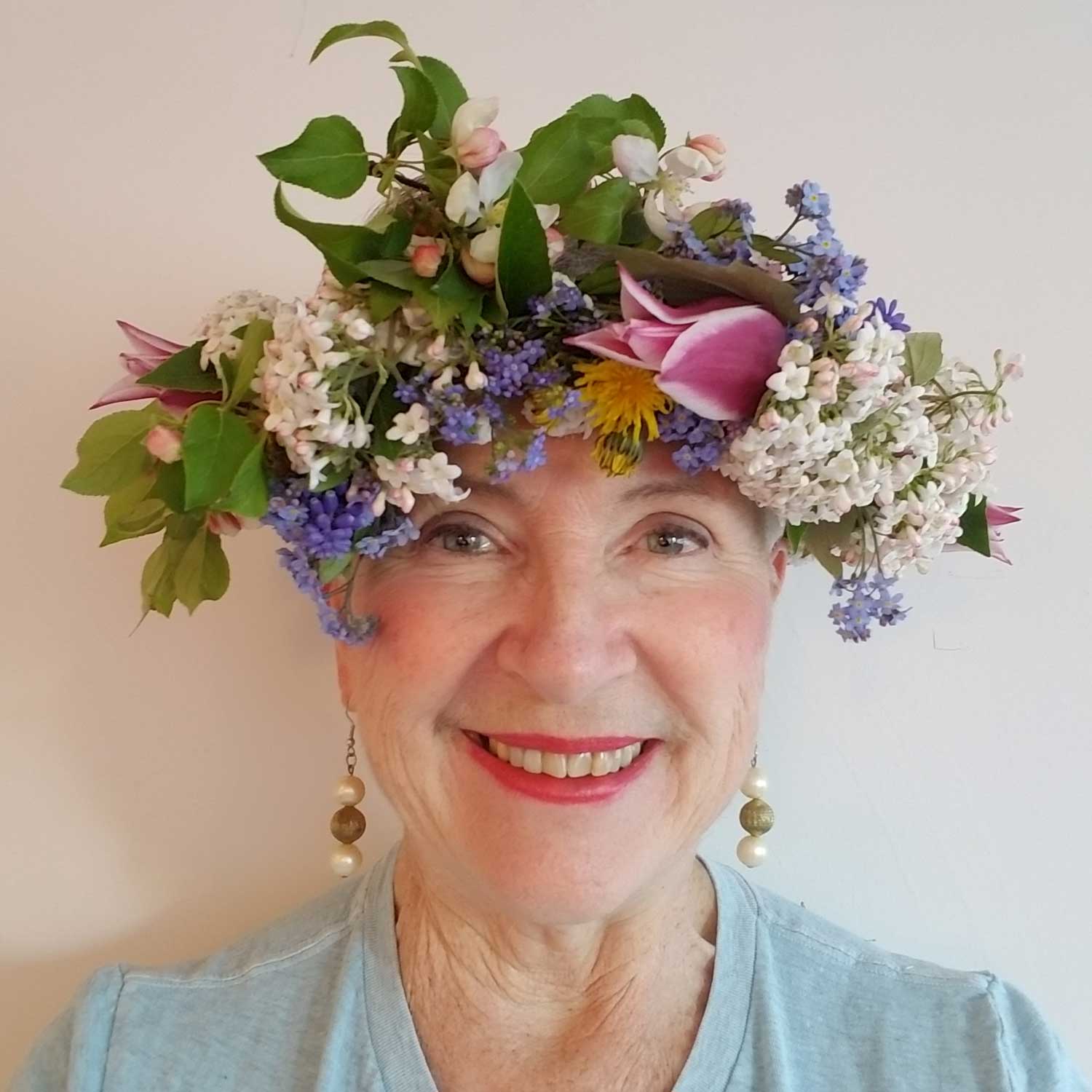
…. but as summer 2021 wore on, it was evident that my crabapple tree was dying. Sadly, these were the last shimmering, May blossoms from the weeping ‘Red Jade’ tree whose branches had cascaded gracefully for 34 years over the lily pond I dug myself in the middle of our back garden. Here’s a photo from 1987 of me with my late dad who was visiting from Vancouver. You can see the newly-planted crabapple to my left.

Since ‘Red Jade’ is an alternate-bearing hybrid, it only put on a good flowering and fruiting show every other summer. Introduced in 1953 as an open-pollinated seedling from Malus × scheideckeri ‘Exzellenz Thiel’ at the Brooklyn Botanic Garden, it is one of just a few weeping crabapples.

In its flower-bearing springs, the tree was alive with bees of all kinds, including bumble bees, below.
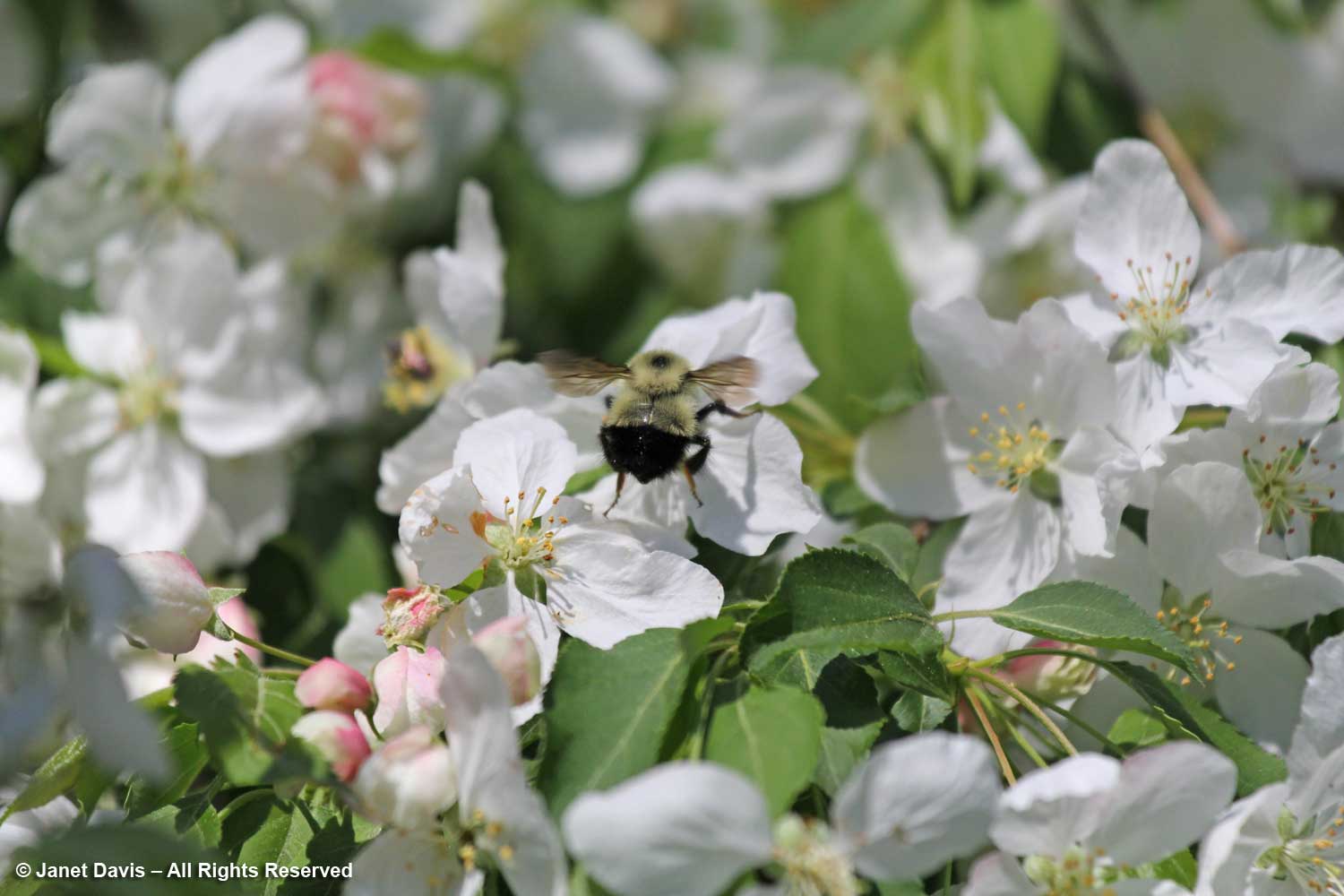
And in late summer, the birds paid visits for the tiny jewelled fruit – the perfect size for their beaks. But you can see in the photo below that the tree had already lost its leaves to apple scab in summer. Gardeners tend to assume trees will outlive them – or certainly last through their ownership of a garden – but this is not always true, especially of crabapples. Still, along with the sadness of losing a cherished plant comes the opportunity to select a replacement; fortunately we now have a broad range of cultivars with resistance to apple scab, fire blight and other diseases. Or perhaps I’ll choose another species, but whatever tree I choose must be as useful to all the bees, birds and animals that have been sustained over the decades by the white flowers and small, jewelled fruit of my ‘Red Jade’ crabapple.

At Christmas, we often strung lights on the crabapple and it lent a festive air to the garden outside our kitchen window.
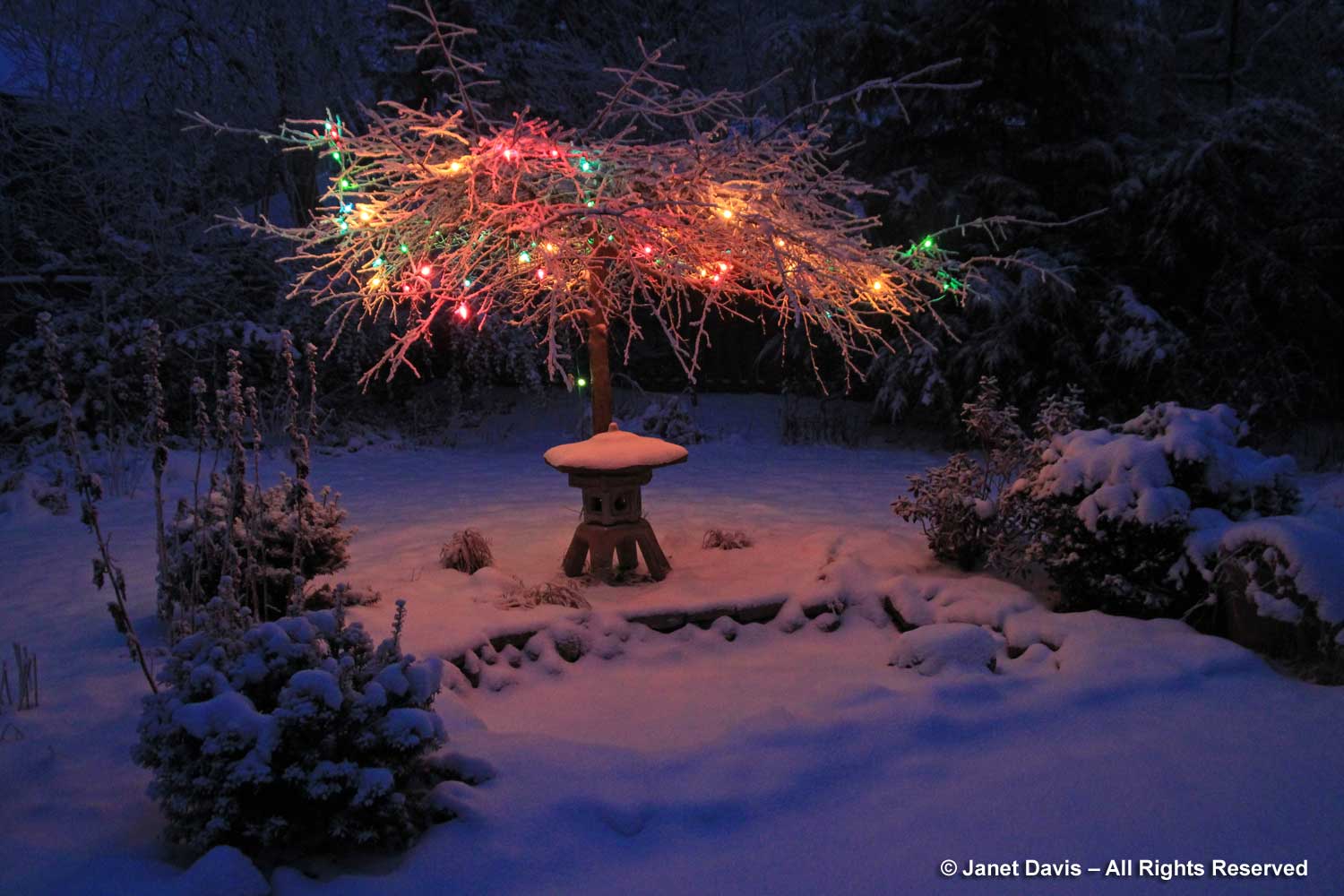
The pond itself remains a vital part of the garden. Though I launched it all those years ago with great ambition and a plan to grow waterlilies and other floating plants, I learned in time that it is one of the higher maintenance features in any garden. The aquatic plants were constantly upended by marauding raccoons; the liner leaked and had to be replaced. So, despite writing a 1997 book called Water in the Garden as part of a magazine-sponsored design series, I gave up on the idea of aquaculture and just treated the pond as a large birdbath and watering hole. And bathe and drink they do: robins, cardinals, sparrows, juncos and many other birds that bring a spark of life to the garden.
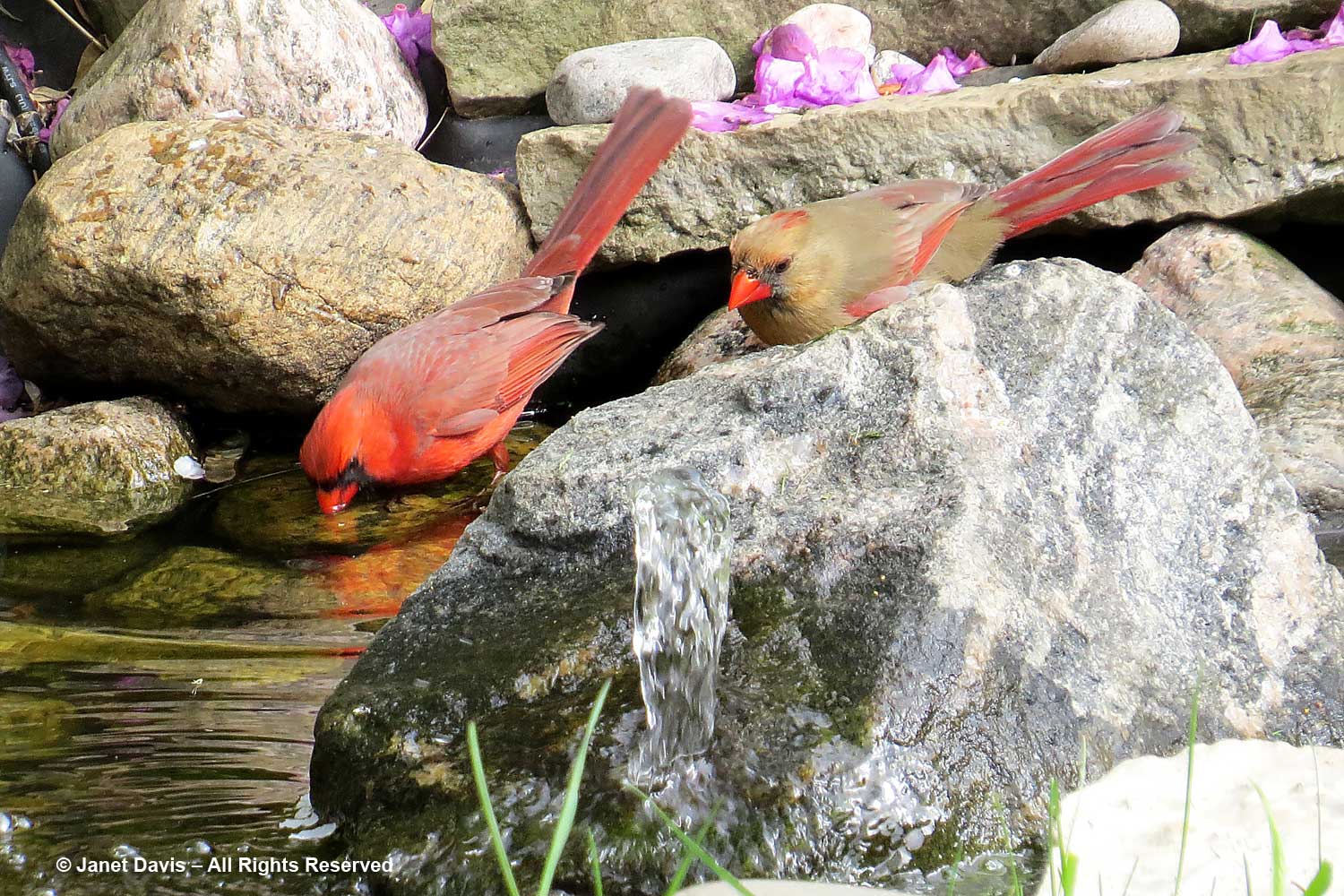
Under the crabapple tree, the crescent-shaped garden around the pond is carpeted in spring with a cloud of blue forget-me-nots (Myosotis sylvatica). So fond am I of this humble little biennial that I once persuaded a magazine editor to let me write its praises. “Sometimes, on a lovely May morning, as I’m looking at the robins bathing in the lily pond in my back garden, I’ll squint a little and imagine what it would look like without that lacy froth of light blue under the ‘Red Jade’ crabapple tree. Dirt, that’s what it would look like, and the emerging green of perennials, of course. But not nearly as enchanting as the soft blue cloud that floats around the lily pond.” When my forget-me-nots stop flowering, I pull them out while giving them a good shake where I want them to bloom the following spring.
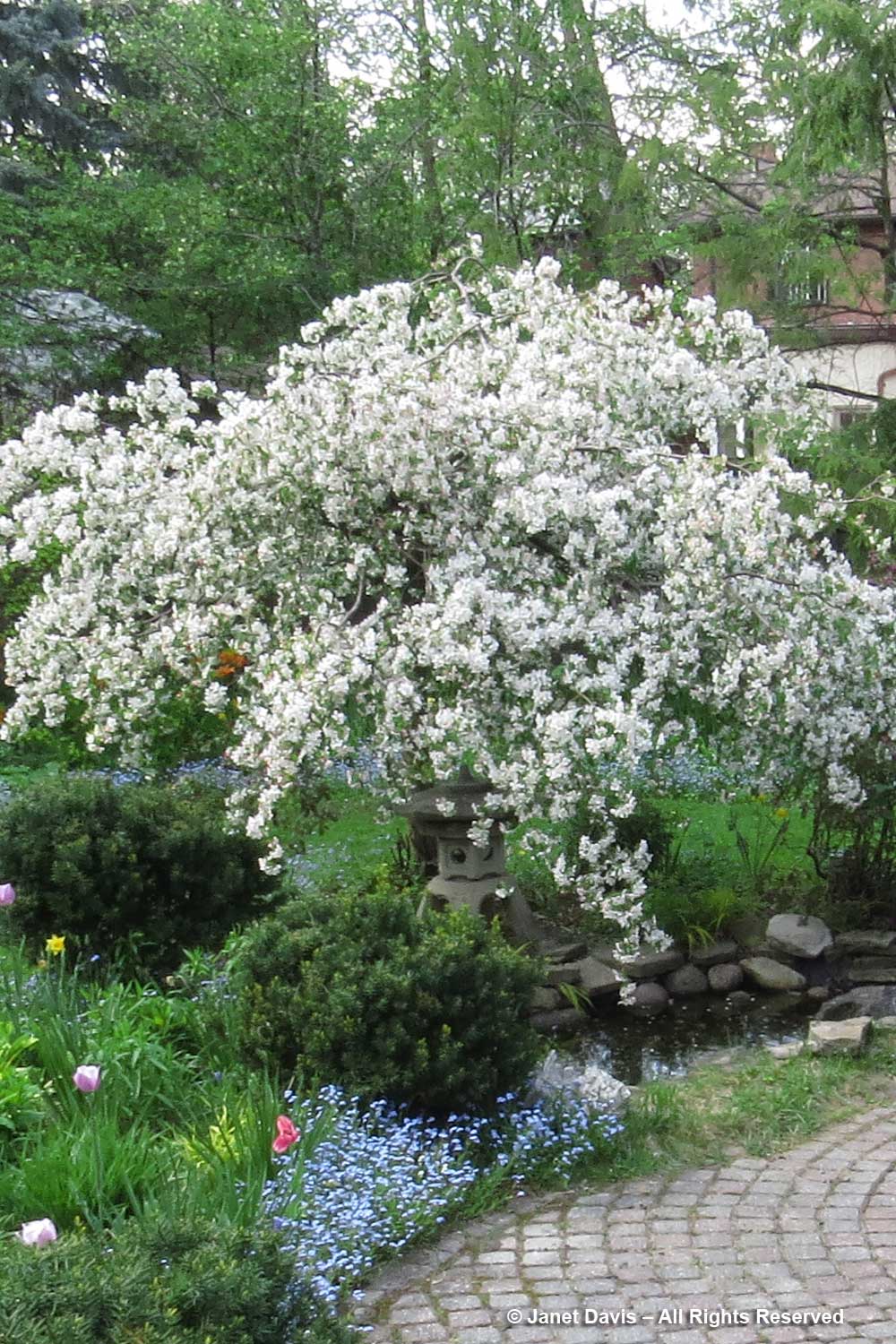
The forget-me-nots flower at the same time as common grape hyacinth (Muscari armeniacum), a lovely symphony in blue. This grape hyacinth with its azure-blue spikes is the last of the genus to bloom in my spring garden and almost hidden in my fairy crown.

Along with the blue Siberian bugloss (Brunnera macrophylla) now hitting its stride and the little Confederate violets (Viola sororia var. priceana) that grow wild in my excuse for a lawn, the forget-me-nots and grape hyacinths look lovely in small bouquets.
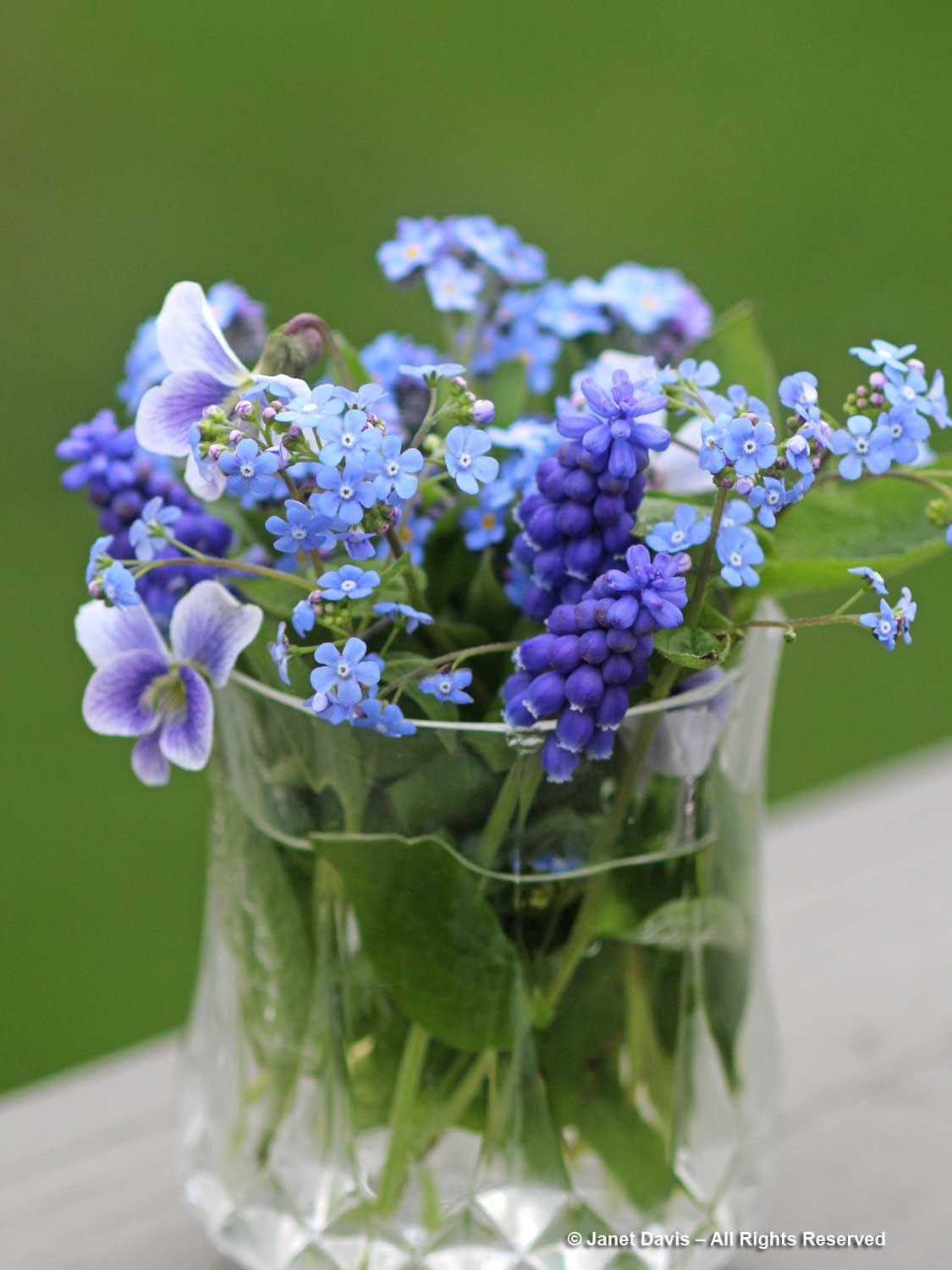
This is Virginia bluebell (Mertensia virginica) time, too – a lovely, native spring ephemeral. I wish I had much more of this beauty.

Ostrich ferns blanket the earth beneath the Burkwood viburnum (V. x burkwoodii) in my sideyard, whose clustered, white flowers are also tucked into my fairy crown. A hybrid of two Asian species, V. carlesii and V. utile, it reaches 10 feet tall and 7 feet wide and is a very low-maintenance shrub, preferring a partly-shaded site….

…. where the perfume from its blossoms permeates the air around it.

Another favourite viburnum, flowering a few days later than Burkwood is the fragrant snowball viburnum (V. x carlcephalum). This shrub grows beside my sundeck so its big, pink-budded, waxy flowers are at just the right height for me to sniff….

…..and to cut and float in a dish so we can enjoy its spicy scent indoors, too.

Though the flowers aren’t in my crown, my serviceberries bloom at this time, too – a pair of tall Amelanchier canadensis shrubs hidden away in a sideyard where I can’t even see them in flower – but the birds have no trouble finding the fruit a few months later!

Tulip season is long, from the Single Early class to the Late or Cottage class; provided temperatures stay somewhat cool, I have tulips in my garden for up to 6 weeks. Lily-flowered ‘Ballade’ is one of my favourites, and reasonably perennial. Its fluted, mauve-pink blossoms edged crisply with white are spectacular, eventually opening to the sun like waterlilies.
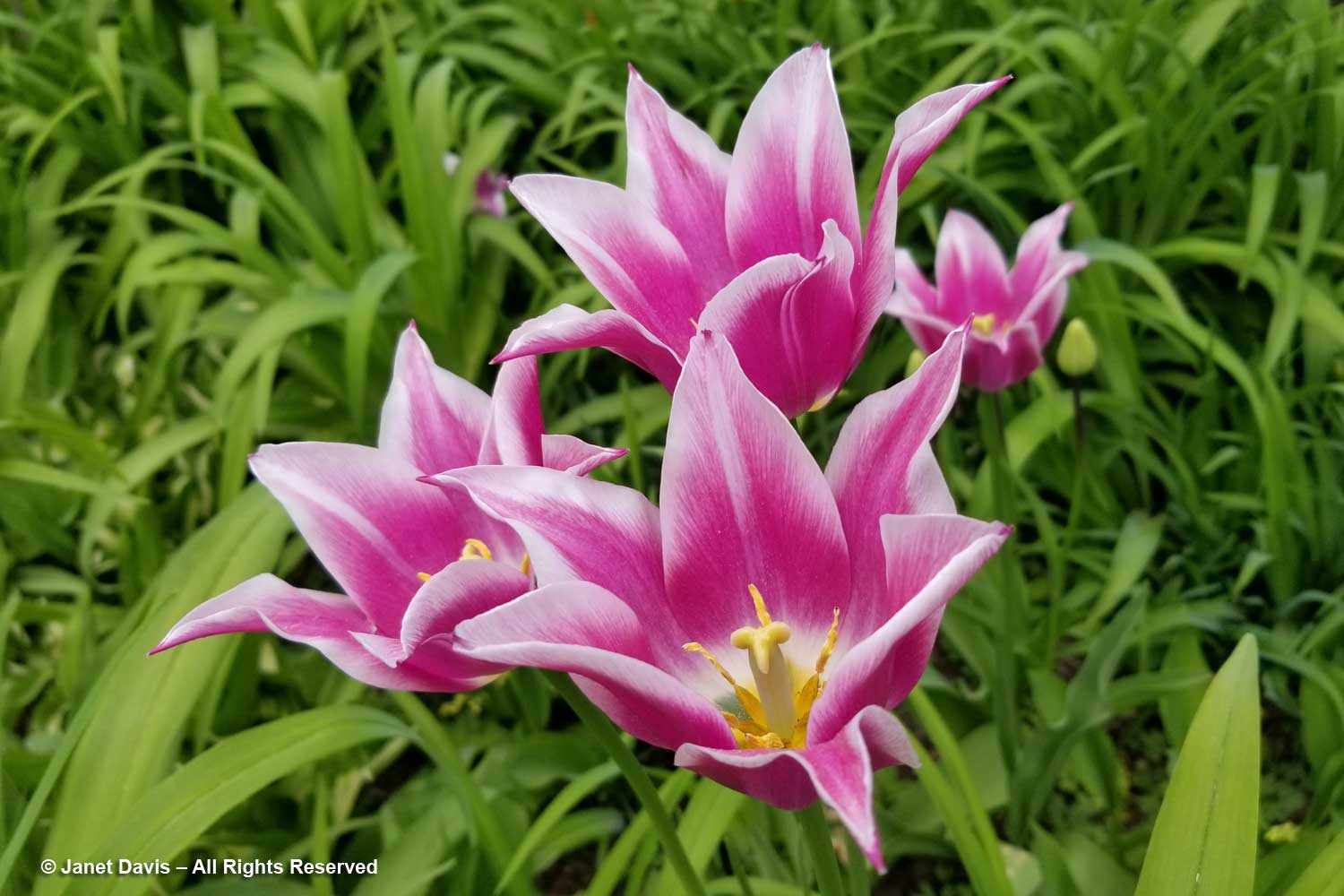
When I removed my fairy crown, I carefully undid the floral tape so I could place the blossoms in water to enjoy for a few days, these treasured blossoms of spring.
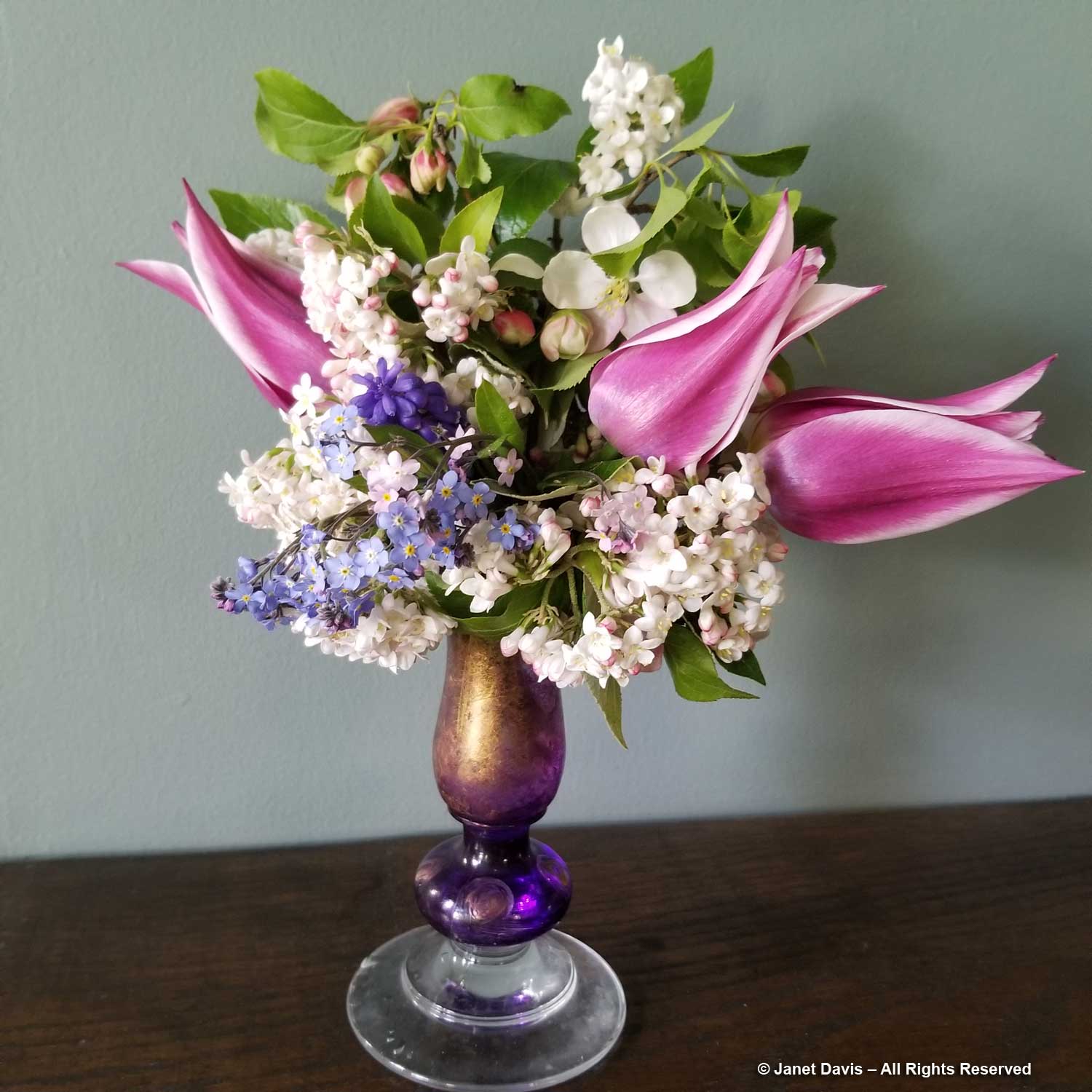
What’s a spring garden without weeds, like the dandelions that greet every May with a flourish? My husband likes the challenge and exercise of trying to keep the garden dandelion-free, and in a place where herbicides for decorative purposes have been rightly outlawed, that requires a lot of hand-weeding.
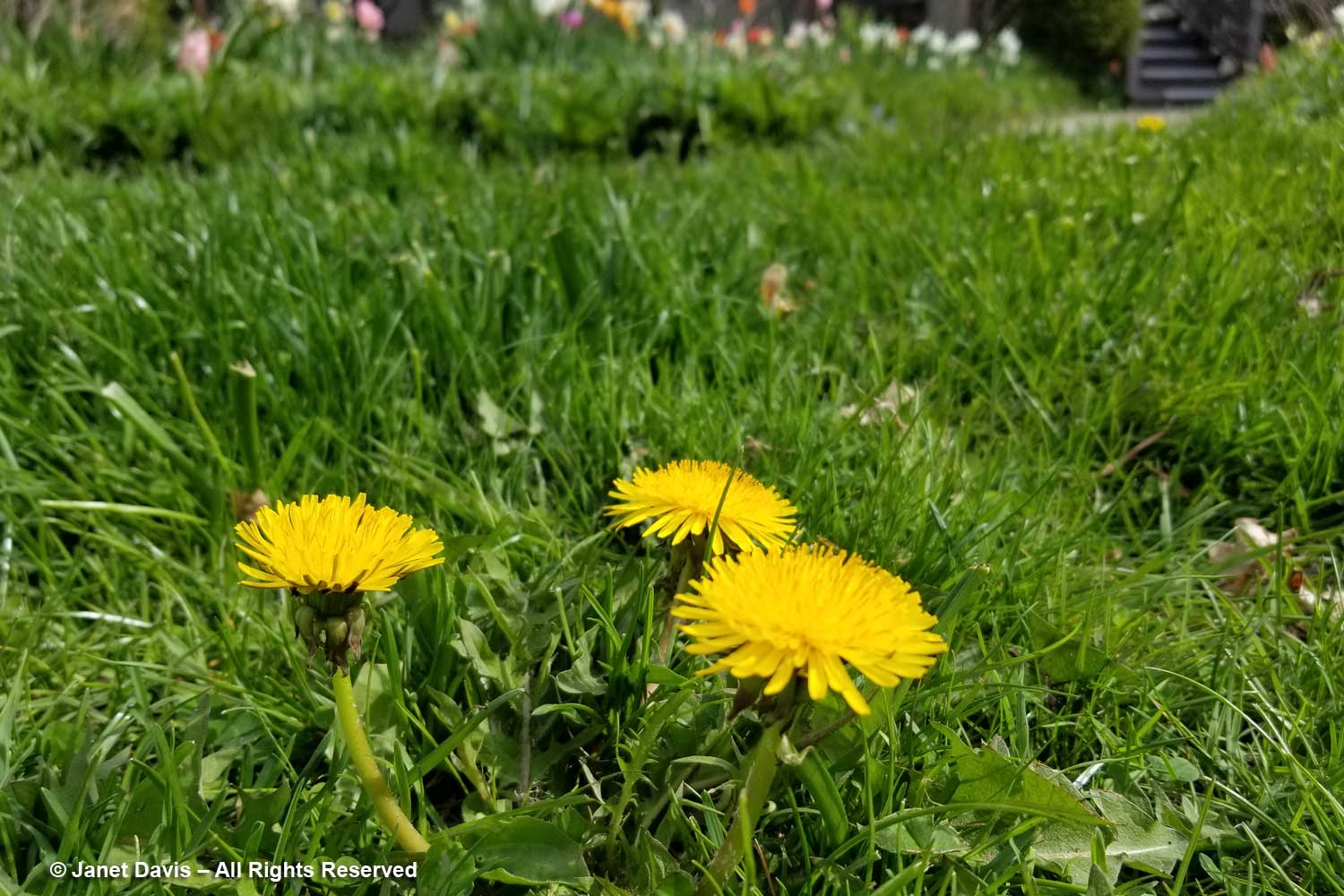
Along with the European dandelions comes another European invader, the red fire ant (Myrmica rubra). This little insect with the mighty sting has become a nuisance pest in gardens throughout temperate North America, including mine. That means if I want to tiptoe through the tulips – and dandelions – of May, I had better be wearing shoes!

And just in case you think that I grow lovely spring bulbs with a few dandelions, my garden also has a healthy crop of invasive garlic mustard (Alliaria petiolata) at this time in spring, especially in the far reaches out of sight. But I drew the line at including this ubiquitous biennial weed in my fairy crown!
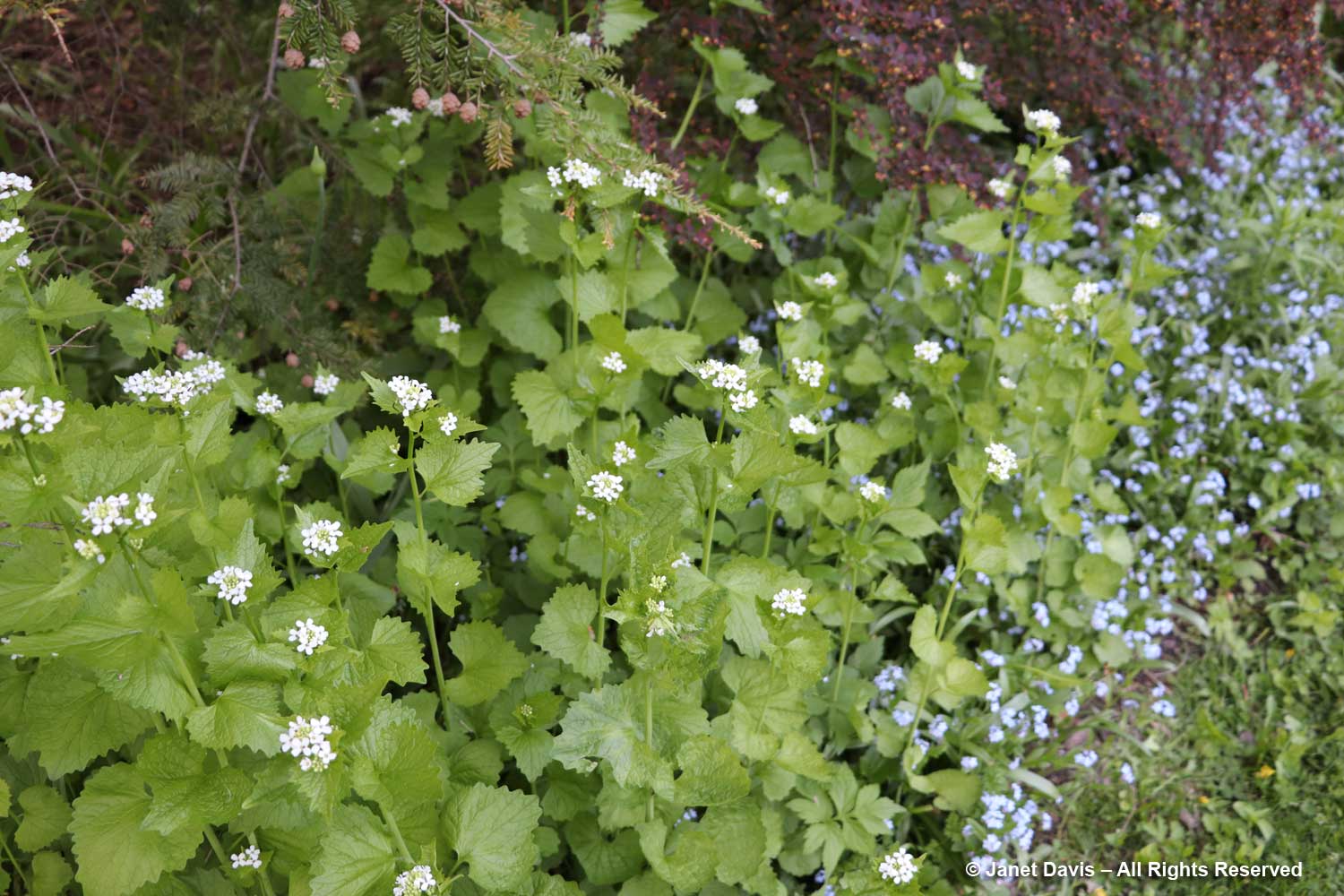
******
Want to see more of my Fairy Crowns?
#1 – Spring Awakening
#2 – Little Blossoms for Easter
#3 – The Perfume of Hyacinths
#4 – Spring Bulb Extravaganza
